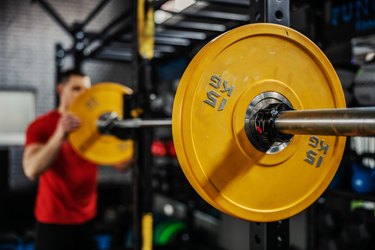
Even the most experienced gym-goers make mistakes: They forget a warm-up once in a while or return dumbbells to the wrong rack (definitely not the best gym etiquette).
But when you make a mistake with a barbell, the stakes are high, considering how much weight these exercises often involve.
Video of the Day
Video of the Day
During your next barbell workout, be on the lookout for any of these common barbell mistakes. It'll help you get more muscle out of your workouts — and stay safe.
Related Reading
1. Placing Your Hands Unevenly
This barbell mistake can be riskier than you'd think, according to California-based physical therapist Jereme Schumacher, DPT.
If you don't place your hands evenly on the barbell (meaning they are both equal distances from the center) the weight won't balance, he says. That can cause the bar to tip or fall to one side, ruining your form and skyrocketing your injury risk.
The same rule applies when you place the bar on your back: You want the bar centered to prevent the weight from tipping to one side.
And all injuries aside, it's so much harder to move a weight and effectively strengthen your body when one side is overloaded and the other is hardly working.
Fix It
Use the ridges on the barbell as a visual guide.
"Always make sure each hand is placed equal distance from the start of the knurl marks [where the metal is rough] in order to ensure proper balance," Schumacher says.
During most exercises, you want to grip the barbell about a thumb's distance away the edge. However, in some barbell exercises, you need a wider or narrower grip.
2. Not Securing the Weight Plates
You might be surprised by how often this mistake is made. Just take a peek around your gym and you'll probably see a few people without weight collars on their barbell. And although it may not seem like a big deal, it's actually pretty dangerous, according to Schumacher.
"Not using weight collars can lead to serious injury risk as well as poor weight distribution throughout the bar," he says. "If the weights are not locked into place, they will most likely slide a little while you are lifting. This will cause uneven distribution of weight, causing poor lifting mechanics."
Forgetting collars not only increases your injury risk but can affect your lifting form and mechanics, Schumacher says. In the long run, this will affect your strength-building progress, hindering your ability to target the right muscles or causing muscle imbalance.
Fix It
This solution is pretty simple: Always use weight collars when you're loading plates onto a barbell, no matter how heavy or light. Make it a habit to check for your collars before every set.
3. Not Wrapping Your Thumbs Around the Bar
One frequent error Schumacher sees with the bench press or overhead press is gripping the bar with the thumb alongside the index finger rather than wrapped around the bar. This position, called a false grip, may feel more comfortable on your wrist, but it's a risky choice.
"Without the barbell securely positioned in your hands, there's a much higher chance that the weight falls out of your hands and potentially lands on you," he says. "In the past few years, multiple weightlifting injuries have been reported due to this grip."
Fix It
Wrap your thumbs completely around the barbell. If you're not able to get your hands into this position, add some exercises for wrist flexibility and mobility into your routine, Schumacher says.
4. Loosening Your Grip
In the middle of your set of back squats, you may feel inclined to loosen your grip on the barbell, allowing it to rest in the palm of your hands. But this may be doing your strength-building efforts a disservice.
The harder you grip the barbell, the more you activate your shoulders and rotator cuff muscles, Schumacher says. This can increase your ability to stabilize the weight.
"A lot of lifters don't actively grip the barbell, especially if they are moving sub-maximum weight," he says. "This can lead to decrease in power generation and potentially decreased shoulder stability."
Fix It
"I generally cue my athlete to start with a firm grip on the barbell, similar to that of a strong handshake," Schumacher says. "Once you have a solid grip, actively squeeze the bar throughout the entire lift."